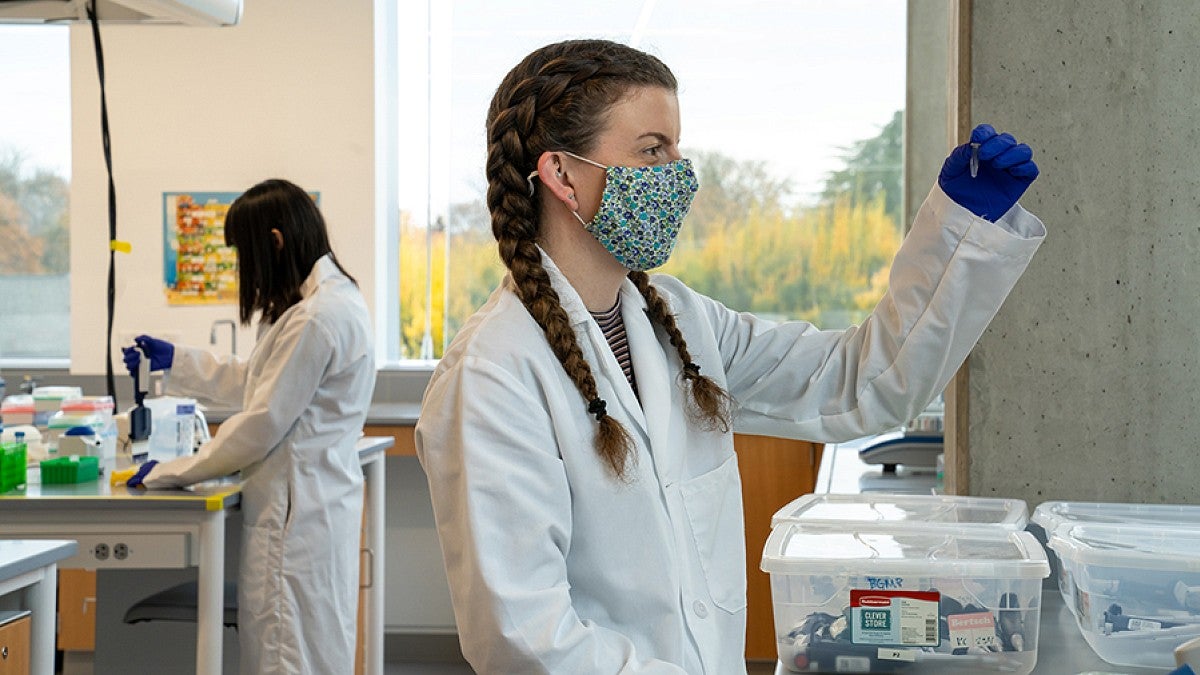The University of Oregon’s Phil and Penny Knight Campus for Accelerating Scientific Impact and Oregon State University’s College of Engineering are combining strengths on a joint bioengineering doctoral program that will provide students access to courses, facilities and faculty at both institutions.
The doctoral program, which marks the first degree program in an engineering discipline at the UO, pairs the entrepreneurial drive of the UO’s Knight Campus with OSU’s strong legacy in the field with the 10th largest engineering program in the U.S. based on undergraduate enrollment.
“I often say science is a team sport,” said Robert Guldberg, UO vice president and Robert and Leona DeArmond Executive Director of the Knight Campus. “Although rivals on football Saturdays, in this case the University of Oregon and Oregon State University are teaming up to provide a Ph.D. program focused on societal impact. This is a prime example of how we are leveraging our collective expertise and resources to attract and train outstanding bioengineering graduate students.”
Set to celebrate the grand opening of its first building on Dec. 2, the UO’s Phil and Penny Knight Campus for Accelerating Scientific Impact is designed to accelerate the cycle of translating scientific discoveries into innovations that improve quality of life for people in Oregon, the nation, and beyond.
Students in the joint degree program have full access to resources at both UO and OSU, including research facilities and collaborations, coursework, training workshops, and student groups.
“We’re very pleased to partner with the UO on this transformative new program,” said Scott Ashford, Kearney Dean of Engineering at OSU. “Together we’re providing the depth and breadth not available at any single institution.”
The new program builds on traditional UO strengths in biology, biochemistry and human physiology. The curriculum emphasizes innovation and entrepreneurship and draws on Knight Campus faculty, many of whom are also entrepreneurs and assist in the development of startup companies, and OSU bioengineering faculty with expertise in microfluidics, diagnostics, cryopreservation, and biomaterials development and characterization.
The program provides a high level of customization, facilitating the pursuit of coursework that has the greatest impact on students’ career goals.
“This program is tailored to meet the needs of individual students, while also providing a blend of traditional classroom and lab work,” said Jim Hutchison, senior associate vice president at the Knight Campus. “To go beyond classroom and research-based learning, we’ve designed a suite of experiential workshops, focused on career development and planning, training in science communications, innovation and entrepreneurship. Taken as a whole, it provides a unique experience while preparing students for their careers.”
At the Knight Campus, students have access to nine independent, faculty-led labs with research areas focused in biofunctional materials, medical sensors and devices, musculoskeletal regeneration, protein engineering and synthetic biology, and neural engineering. Students will have access to and expert guidance in using facilities designed for rapid prototyping, 3D printing and bioprinting, x-ray imaging and a clean room to support fabrication of microscale and nanoscale devices.
At OSU, students benefit from the cross-disciplinary collaboration between engineering, veterinary medicine and pharmacy. Additionally, they will have access to unique research capabilities at the new Biomedical Prototyping and Characterization Facility and facilities within the National Science Foundation Northwest Nanotechnology Infrastructure.
“Combining the expertise between faculty at the Knight campus and OSU’s bioengineering elevates the stature and impact of the joint program,” said Gregory Herman, head of the School of Chemical, Biological, and Environmental Engineering and James and Shirley Kuse Chair in Chemical Engineering at OSU. “Over the past decade OSU has made significant investments in bioengineering, including faculty hires and new research capabilities, and continues to leverage unique capabilities across the college and the university to make impacts on the health of Oregonians.”
The Knight Campus welcomed the first cohort this year. Sam Lester, who earned his undergraduate degree in mechanical engineering and material science at Duke University, chose the UO’s Knight Campus because of its focus on hands-on training, state-of-the-art facilities and the innovative curriculum of the doctoral program.
“Each project I am working on already requires a versatile approach,” he said. “The expert training I am receiving is jump-starting me to take advantage of every aspect of the Knight Campus.”
—By Zack Barnett, University Communications


